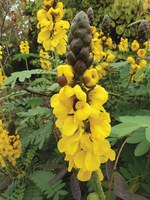Dakota Gardener: Popcorn in the garden
(Click an image below to view a high-resolution image that can be downloaded)
By Kelsey Deckert, Horticulture agent
NDSU Extension - Burleigh County
The other night, my husband and I went to the movie theater, which I can’t remember the last time we went to see a movie. The most popular snack at the movie theater is, of course, buttered popcorn. As we were munching on the popcorn, the idea for this column struck me: the popcorn plant!
The technical name is popcorn cassia, but it is called the popcorn plant for short. The extraordinary characteristic of the plant is that if you rub the leaves, you will smell buttered popcorn! I was first introduced to this plant several years ago when my mom was convinced at a garden center that she needed one for a container garden. I will never forget her excitement having me rub the leaves and smell the aroma.
Popcorn cassia is a tropical, multi-branching shrub or small tree from Africa that is only hardy in zones 9-11. It can grow up to 25 feet, but typically stays around 6-10 feet tall. It has pinnately compound leaves and usually blooms in late summer when temperatures are warm. The flowers are a bright, “buttery” yellow. It has been commented that the flowers have a slight peanut butter aroma. The fruits that follow are flat legume pods.
Many gardeners will purchase the popcorn cassia as a container or accent plant for their garden. It is easy to care for the popcorn cassia, making sure it is in full sun with a well-drained soil. It will thrive in hot, humid weather and benefit from regular fertilizing. There are no significant pests or diseases. It can tolerate a light frost, but should be brought indoors when nighttime temperatures start to fall below 40 degrees Fahrenheit.
If you are a gardener who likes to start seeds, you can easily start them in late February or March. You will want to soak the seeds in water for 24 hours prior to planting them in soil.
Popcorn cassia can be a great addition as a sensory plant for educating youth. It also makes a great pollinator plant. The plant is poisonous if ingested, so be cautious with pets who nibble or young children, making sure they don’t eat it because of the smell.
For more information about popcorn cassia, contact your local NDSU Extension agent. Find the Extension office for your county at ndsu.ag/countyoffice.
NDSU Agriculture Communication – July 16, 2025
Source: Kelsey Deckert, 701-221-6865, kelsey.j.deckert@ndsu.edu
Editor: Kelli Anderson, 701-231-6136, kelli.c.anderson@ndsu.edu




